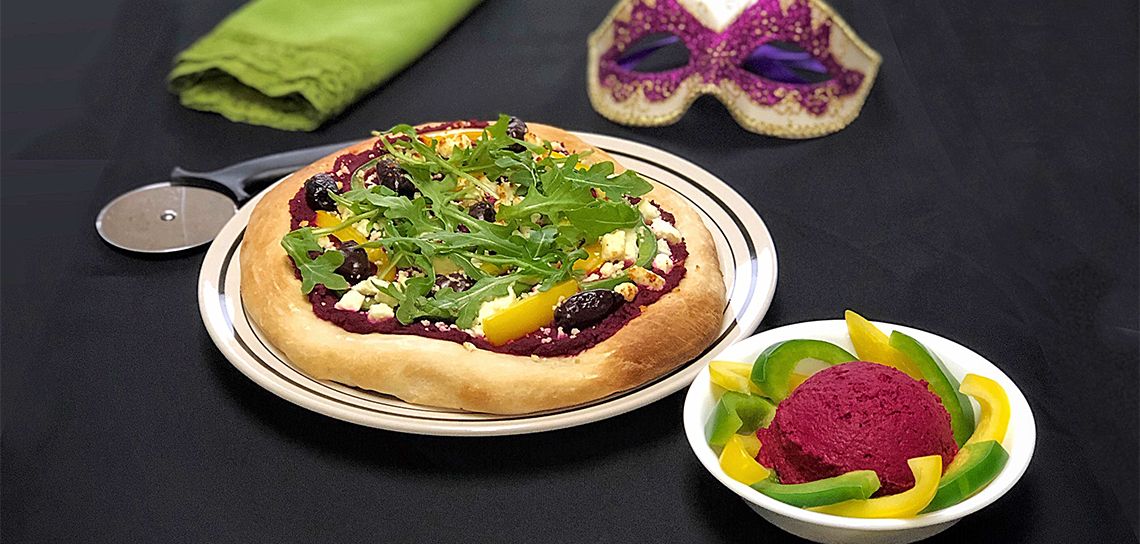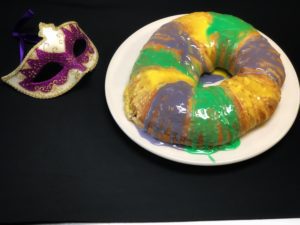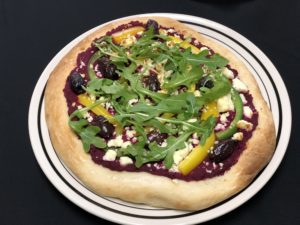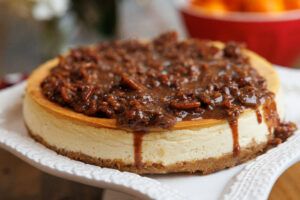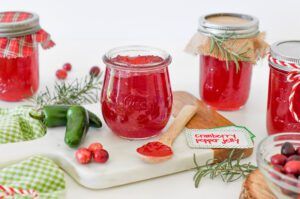Cuisine: Mardi Gras with “More”
Many of us focus on what we can give up at the beginning of a new year. We may want to eat less sugar or less fat, drink less alcohol, or just eat less in general. However, one of the best things about being a Louisianan (Mardi Gras!) is also one of the reasons maintaining a “less” mentality in regards to food is so hard.
Even those of us with the best of intentions are easily sabotaged during Carnival season. Putting restrictive diets up against the delicious temptations we’re faced with each day can make us feel like we’re fighting a losing battle. Restricting access to the delicious foods we want to eat can cause us to want the food more, and soon we find ourselves giving into temptation and overeating, or feeling guilty about the indiscretion, even if we haven’t overeaten.
One strategy I like to use to stay on track with maintaining a healthy lifestyle throughout the year while avoiding diet guilt is putting less emphasis on “less” and instead focusing on “more.” Instead of resolving to eat less sugar or fewer calories, try resolving to add more fruits and vegetables to your diet, more whole grains, or more awareness to eating. Try adding a new food to your diet that you don’t normally eat, or resolve to try a food you used to dislike.
In true Mardi Gras spirit, these recipes focus on adding more. Smoothies are a great way to add nutritious foods that you may not normally eat to your diet and are one of my favorite ways to add more vegetables to breakfasts and snacks. Our colorful Mardi Gras Smoothies combine vegetables like purple cabbage, yellow squash and spinach with fruits like pineapple, bananas and kiwi to create a nutritious and tasty breakfast or snack. Each smoothie is delicious on its own, but all three together create an extra colorful treat.
Our Honey Whole Wheat King Cake recipe includes the addition of whole wheat flour to the dough, and toasted pecans and Neufchatel cheese to the filling. Whole wheat flour adds vitamins, minerals and dietary fiber. Neufchatel cheese adds the protein and flavor of traditional cream cheese with a bit less saturated fat, and pecans provide heart-healthy unsaturated fats. I encourage those who have never made a king cake from scratch to try it! It’s easier than you may think and can be a fun activity to do as a family.
Our last recipe is a Mardi Gras Pizza, aptly named for its colorful purple, green and gold ingredients. Mardi Gras-colored veggies not only add flavor but important vitamins and minerals. Our Roasted Beet Hummus can also be eaten on its own with sliced veggies, crackers or pita bread. It’s a great way to incorporate nutritious beets into your diet if you’re not fond of their flavor alone.
Try using these recipes to celebrate Mardi Gras this month with “more.” Continue to focus on adding nutritious foods, and you’ll be set for success during this season and for holiday seasons to come!
MARDI GRAS SMOOTHIES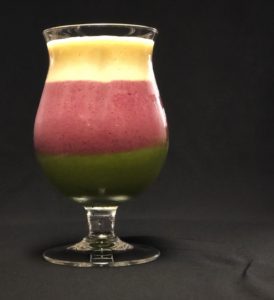
Green Smoothie:
½ avocado
½ banana
½ cucumber, peeled
1 cup baby spinach
4 oz. apple juice
½ tsp. vanilla
Gold Smoothie:
1 cup pineapple, canned, drained, juice reserved
½ cup reserved pineapple juice
½ cup yellow squash, frozen
1 banana
½ cup Greek yogurt
Purple Smoothie:
1 cup blueberries, frozen
2⁄3 cup shredded purple cabbage
1 banana
1 kiwi, peeled
½ cup Greek yogurt
½ cup water
To layer smoothies, blend ingredients for green layer and divide evenly between 4 glasses. Place glasses in freezer for 8 to 10 minutes while preparing gold layer. Make sure to rinse blender between layers.
Blend ingredients for gold layer until smooth. Remove glasses from freezer. Using a spoon, drizzle gold layer on top of green layer. Return glasses to freezer for 8 to 10 minutes while preparing purple layer. Rinse blender between layers.
Blend ingredients for purple layer until smooth. Remove glasses from freezer. Using a spoon, drizzle purple layer on top of yellow layer.
Makes 4 layered smoothies.
Nutritional information per serving:
Calories 250 | Fat 5g | Carbohydrates 47g | Fiber 7g | Protein 9g
HONEY WHOLE WHEAT KING CAKE WITH PECAN CREAM CHEESE FILLING
Cake:
½ cup low-fat milk, warmed slightly
1 (3⁄4-oz.) envelope instant yeast
3 Tbsp. honey
2 large eggs
1½ cups all-purpose flour
1 cup whole wheat flour
½ tsp. salt
6 Tbsp. salted butter, softened
Filling:
8 oz. Neufchatel cheese (or reduced-fat cream cheese)
¼ cup granulated sugar
1 large egg
1 tsp. vanilla
1 ½ tsp. ground cinnamon
½ cups pecan halves, toasted and chopped
Glaze:
2½ cups confectioners’ sugar
1⁄3 cup low-fat milk
1 tsp. vanilla extract
Purple (or red and blue), green, and yellow food dye
For Cake, combine warmed milk and yeast in the bowl of a stand mixer and let sit for 5 minutes. Add honey and eggs, and stir until combined. Add flours and salt. Mix until combined, then knead with a dough hook for about 2 minutes at a low speed or until it looks smooth. Increase speed to medium and add butter, 1 Tbsp. at a time. Once butter is added, continue kneading dough for about 5 minutes—dough will be soft and stick to sides of bowl. If dough looks too soft or sticky (for example, if it sticks to your fingers), add a couple additional Tbsp. flour and knead dough for a few more minutes. Cover bowl with plastic wrap and let it rise at room temperature for about 2 hours or until at least doubled in size.
For Filling, beat together Neufchatel, granulated sugar, egg, vanilla and cinnamon until mostly smooth. Refrigerate mixture while dough rises (or for at least 1 hour).
Line a baking sheet with parchment paper, and spray with non-stick cooking spray. Turn dough out onto parchment, and shape into a rectangle. Spread filling on top of dough in an even layer, and sprinkle pecans on top. Roll up dough into a log, and situate it so seam is facing down. Shape log into a circle and pinch ends together. Cover loosely with plastic wrap and let it rise once more for 30 minutes.
Bake at 350 degrees for 20 to 30 minutes or until golden brown.
Once cake is cooled, create Glaze by whisking together confectioners’ sugar, milk and vanilla until smooth. For thicker glaze, add additional confectioners’ sugar in 2-Tbsp. increments until desired consistency is achieved. Separate into 3 bowls, and use food dye to color 1 bowl purple (2 drops of blue, 1 drop of red), 1 green, and 1 yellow. Drizzle glaze onto cake, alternating the 3 colors. Glaze should harden within 1 hour, and then cake will be ready to enjoy!
Makes 12 servings.
Nutritional information per serving:
Calories 300 | Fat 14g | Carbohydrates 38g | Fiber 2g | Protein 7g
MARDI GRAS PIZZA
14 oz. pizza crust dough
1 cup Roasted Beet Hummus (see recipe below)
¼ cup chopped green peppers
¼ cup sliced yellow peppers
¼ cup Kalamata olives
1⁄3 cup feta cheese
½ cup arugula
½ tsp. lemon juice
Preheat oven to 400 degrees. Roll out dough into desired shape and thickness. Bake on a baking sheet or stone for 8 minutes. Spread Roasted Beet Hummus evenly on crust. Top with green and yellow peppers, Kalamata olives and feta cheese, and return pizza to oven to bake for 6 to 10 more minutes.
In a small bowl, toss arugula with lemon juice. Once pizza is removed from oven, top with fresh arugula.
Makes 4 servings.
Nutritional information
per serving:
Calories 400 | Fat 12g Carbohydrates 59g | Fiber 7g Protein 15g
(Nutrients will vary depending on dough used.)
Roasted Beet Hummus:
1 medium beet (or about 2⁄3 cup diced canned beets)
2 Tbsp. olive oil, divided
1(15-oz.) can chickpeas, drained and rinsed
2 tsp. minced garlic
2 Tbsp. lemon juice
¼ cup tahini
1 tsp. salt, or more to taste
Preheat oven to 350 degrees Cut off stem and root, and wash beet. Drizzle beet with 1 Tbsp. olive oil and wrap in foil. Roast for 1 hour or until tender. Peel and chop beet after letting it cool to room temperature. Add chopped beet, chickpeas, garlic, lemon juice, tahini, remaining 1 Tbsp. olive oil and salt to a food processor or blender. Process until smooth, scraping down sides of bowl as necessary.
Makes about 12 (¼-cup) portions.
Nutritional information per serving:
Calories 85 | Fat 4g | Carbohydrates 10g | Fiber 2g Protein 3g
Renee Puyau is a registered dietitian and the director of the Metabolic Kitchen at LSU’s Pennington Biomedical Research Center. Find more recipes at pbrc.edu/kitchen.




